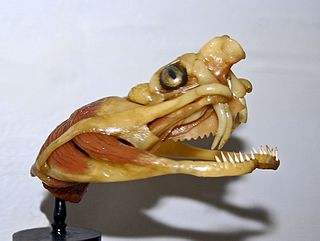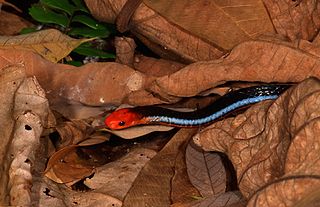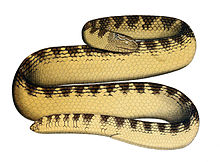
Venom or zootoxin is a type of toxin produced by an animal that is actively delivered through a wound by means of a bite, sting, or similar action. The toxin is delivered through a specially evolved venom apparatus, such as fangs or a stinger, in a process called envenomation. Venom is often distinguished from poison, which is a toxin that is passively delivered by being ingested, inhaled, or absorbed through the skin, and toxungen, which is actively transferred to the external surface of another animal via a physical delivery mechanism.

Elapidae is a family of snakes characterized by their permanently erect fangs at the front of the mouth. Most elapids are venomous, with the exception of the genus Emydocephalus. Many members of this family exhibit a threat display of rearing upwards while spreading out a neck flap. Elapids are endemic to tropical and subtropical regions around the world, with terrestrial forms in Asia, Australia, Africa, and the Americas and marine forms in the Pacific and Indian Oceans. Members of the family have a wide range of sizes, from the 18 cm (7.1 in) white-lipped snake to the 5.85 m king cobra. Most species have neurotoxic venom that is channeled by their hollow fangs, and some may contain other toxic components in various proportions. The family includes 55 genera with around 360 species and over 170 subspecies.

Snake venom is a highly toxic saliva containing zootoxins that facilitates in the immobilization and digestion of prey. This also provides defense against threats. Snake venom is injected by unique fangs during a bite, whereas some species are also able to spit venom.

Toxicofera is a proposed clade of scaled reptiles (squamates) that includes the Serpentes (snakes), Anguimorpha and Iguania. Toxicofera contains about 4,600 species, of extant Squamata. It encompasses all venomous reptile species, as well as numerous related non-venomous species. There is little morphological evidence to support this grouping; however, it has been recovered by all molecular analyses as of 2012.

Stokes's sea snake is a large species of sea snake in the family Elapidae. It is sometimes placed in its own genus Astrotia. The species is endemic to tropical Indo-Pacific oceanic waters.

Hydrophis belcheri, commonly known as the faint-banded sea snake or Belcher's sea snake, is an extremely venomous species of elapid sea snake. It has a timid temperament and would normally have to be subjected to severe mistreatment before biting. Usually those bitten are fishermen handling nets, although only one-quarter of those bitten are envenomated since the snake rarely injects much of its venom. Although not much is known about the venom of this species, its LD50 toxicity in mice has been determined to be 0.24 mg/kg when delivered intramuscularly.

The yellow-lipped sea krait, also known as the banded sea krait or colubrine sea krait, is a species of venomous sea snake found in tropical Indo-Pacific oceanic waters. The snake has distinctive black stripes and a yellow snout, with a paddle-like tail for use in swimming.

Sea snakes, or coral reef snakes, are elapid snakes that inhabit marine environments for most or all of their lives. They belong to two subfamilies, Hydrophiinae and Laticaudinae. Hydrophiinae also includes Australasian terrestrial snakes, whereas Laticaudinae only includes the sea kraits (Laticauda), of which three species are found exclusively in freshwater. If these three freshwater species are excluded, there are 69 species of sea snakes divided between seven genera.

Aipysurus laevis is a species of venomous sea snake found in the Indo-Pacific. Its common names include golden sea snake, olive sea snake, and olive-brown sea snake.

Aipysurus is a genus of venomous snakes in the subfamily Hydrophiinae of the family Elapidae. Member species of the genus are found in warm seas from the Indian Ocean to the Pacific Ocean.

Calliophis bivirgatus is a species of snake in the family Elapidae known commonly as the blue coral snake or blue Malayan coral snake. It is native to Southeast Asia.

Hydrophis peronii, commonly known as the horned sea snake, Peron's sea snake, and the spiny-headed seasnake, is a species of venomous snake in the subfamily Hydrophiinae of the family Elapidae. The species is endemic to the western tropical Pacific Ocean. It is the only sea snake with spines on the head. It is sometimes placed in its own genus Acalyptophis.
Aipysurus duboisii, also known commonly as Dubois' sea snake and the reef shallows sea snake, is a species of extremely venomous snake in the subfamily Hydrophiinae of the family Elapidae. Its geographic range includes Papua New Guinea, New Caledonia and the northern, eastern and western coastal areas of Australia, that is the Coral Sea, Arafura Sea, Timor Sea and Indian Ocean. It lives at depths up to 80 meters in coral reef flats, sandy and silty sediments which contain seaweed, invertebrates and corals or sponges that can serve as shelter. It preys upon moray eels and various fish that live on the seafloor, up to 110 cm in size. A. duboisii is viviparous, giving birth to live young rather than laying eggs. It displays medium aggressiveness, i.e., will bite if provoked, but not spontaneously. The fangs are 1.8 mm long, which are relatively short for a snake, and the venom yield is 0.43 mg. Aipysurus duboisii is a crepuscular species, meaning that it is most active at dawn and dusk.

Emydocephalus is a genus of sea snakes, also known as turtle-headed sea snakes, in the family Elapidae. The genus is one of a small group of the viviparous sea snakes with Aipysurus. Unlike most sea snakes, the species that make up Emydocephalus lack teeth on their dentary and palatine bones. They also lack venom, making them the only non-venomous elapids. The dentary and palantine bones bear only a row of papillae. Emydocephalus does, however, bear fangs and many small pterygoid teeth. This reduced dentition is due to their diet consisting almost entirely of fish eggs. Due to their prey being small and immobile, they exhibit a foraging strategy different than most snakes, where they forage more frequently but consume smaller quantities.

Emydocephalus annulatus, commonly known as the turtleheaded sea snake or egg-eating sea snake, is a species of sea snake that can be found in waters of Oceania near Australia and some Pacific Islands such as the Philippines and the Loyalty Islands of New Caledonia. The geographic range is sporadic, for example, with populations distributed near the eastern and western coasts of Australia in the Great Barrier Reef and the Timor Sea reefs, respectively. They do not, however, occur in the Gulf of Carpentaria along the north coast.

Venom in snakes and some lizards is a form of saliva that has been modified into venom over its evolutionary history. In snakes, venom has evolved to kill or subdue prey, as well as to perform other diet-related functions. While snakes occasionally use their venom in self defense, this is not believed to have had a strong effect on venom evolution. The evolution of venom is thought to be responsible for the enormous expansion of snakes across the globe.

Three-finger toxins are a protein superfamily of small toxin proteins found in the venom of snakes. Three-finger toxins are in turn members of a larger superfamily of three-finger protein domains which includes non-toxic proteins that share a similar protein fold. The group is named for its common structure consisting of three beta strand loops connected to a central core containing four conserved disulfide bonds. The 3FP protein domain has no enzymatic activity and is typically between 60-74 amino acid residues long. Despite their conserved structure, three-finger toxin proteins have a wide range of pharmacological effects. Most members of the family are neurotoxins that act on cholinergic intercellular signaling; the alpha-neurotoxin family interacts with muscle nicotinic acetylcholine receptors (nAChRs), the kappa-bungarotoxin family with neuronal nAChRs, and muscarinic toxins with muscarinic acetylcholine receptors (mAChRs).

Three-finger proteins or three-finger protein domains are a protein superfamily consisting of small, roughly 60-80 amino acid residue protein domains with a common tertiary structure: three beta strand loops extended from a hydrophobic core stabilized by disulfide bonds. The family is named for the outstretched "fingers" of the three loops. Members of the family have no enzymatic activity, but are capable of forming protein-protein interactions with high specificity and affinity. The founding members of the family, also the best characterized by structure, are the three-finger toxins found in snake venom, which have a variety of pharmacological effects, most typically by disruption of cholinergic signaling. The family is also represented in non-toxic proteins, which have a wide taxonomic distribution; 3FP domains occur in the extracellular domains of some cell-surface receptors as well as in GPI-anchored and secreted globular proteins, usually involved in signaling.

Egg predation or ovivory is a feeding strategy in many groups of animals (ovivores) in which they consume eggs. Since a fertilized egg represents a complete organism at one stage of its life cycle, eating an egg is a form of predation, the killing of another organism for food.
Aipysurus mosaicus is a species of snake found in coastal seas of Australia. It is commonly known as the mosaic sea snake.

















